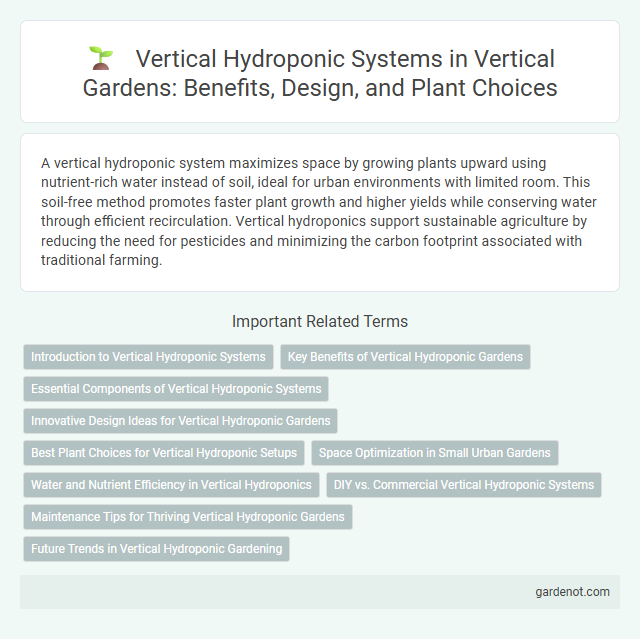A vertical hydroponic system maximizes space by growing plants upward using nutrient-rich water instead of soil, ideal for urban environments with limited room. This soil-free method promotes faster plant growth and higher yields while conserving water through efficient recirculation. Vertical hydroponics support sustainable agriculture by reducing the need for pesticides and minimizing the carbon footprint associated with traditional farming.
Introduction to Vertical Hydroponic Systems
Vertical hydroponic systems utilize nutrient-rich water solutions to grow plants in vertically stacked layers, optimizing space and resource efficiency. This soil-less cultivation method enhances plant growth rates and yields by delivering precise nutrients directly to the roots. Vertical hydroponics is increasingly adopted in urban agriculture and controlled environments to maximize productivity within limited spaces.
Key Benefits of Vertical Hydroponic Gardens
Vertical hydroponic systems maximize space efficiency by allowing plants to grow upwards, making them ideal for urban environments with limited land. These systems significantly reduce water usage, often up to 90% less than traditional soil gardening, through recirculation techniques. Enhanced nutrient delivery in vertical hydroponic gardens promotes faster plant growth and higher yields compared to conventional methods.
Essential Components of Vertical Hydroponic Systems
Vertical hydroponic systems rely on essential components such as nutrient delivery channels, which efficiently circulate water infused with vital minerals to plant roots. Aeroponic misters or drip emitters provide precise hydration, ensuring optimal oxygen levels and preventing waterlogging. Integrated LED grow lights promote photosynthesis in compact spaces, while structural frames support vertical plant growth, maximizing space utilization and yield.
Innovative Design Ideas for Vertical Hydroponic Gardens
Vertical hydroponic systems utilize space-efficient designs that integrate stacked layers or modular panels, maximizing plant growth in limited areas. Innovative vertical hydroponic gardens often feature smart irrigation technologies and automated nutrient delivery, enhancing water and nutrient use efficiency. Incorporating LED grow lights and climate control elements further optimizes plant health and yield in indoor or urban environments.
Best Plant Choices for Vertical Hydroponic Setups
Leafy greens such as lettuce, spinach, and kale thrive in vertical hydroponic systems due to their rapid growth and shallow root requirements. Herbs like basil, mint, and cilantro are ideal for maximizing space and benefiting from consistent nutrient delivery. Strawberries and cherry tomatoes also perform well, offering high yields in confined vertical hydroponic setups.
Space Optimization in Small Urban Gardens
Vertical hydroponic systems maximize space utilization in small urban gardens by stacking plants vertically, allowing more crops to grow in limited footprints. These systems use nutrient-rich water instead of soil, reducing the need for large planting areas and enabling efficient water use. Advanced vertical hydroponic setups increase yield density, making them ideal for compact urban environments with restricted outdoor space.
Water and Nutrient Efficiency in Vertical Hydroponics
Vertical hydroponic systems maximize water and nutrient efficiency by recirculating solutions through stacked growing channels, significantly reducing water waste compared to traditional soil gardening. Precise delivery of nutrient-rich water directly to plant roots minimizes runoff and nutrient loss, enhancing growth rates while conserving resources. This closed-loop system promotes sustainable urban farming by optimizing resource use and supporting high-density crop production in limited spaces.
DIY vs. Commercial Vertical Hydroponic Systems
Vertical hydroponic systems offer efficient space utilization by growing plants without soil in vertically stacked layers, making them ideal for urban gardening. DIY vertical hydroponic systems provide cost-effective, customizable setups that allow hobbyists to experiment with nutrient delivery and plant arrangement, while commercial vertical hydroponic systems deliver advanced automation, scalable production, and optimized climate control for consistent high yields. Choosing between DIY and commercial options depends on budget, technical expertise, and desired production scale, with commercial systems favored for large-scale, high-efficiency farming.
Maintenance Tips for Thriving Vertical Hydroponic Gardens
Regular monitoring of nutrient levels and pH balance ensures optimal growth in a vertical hydroponic system. Cleaning pumps, tubing, and grow trays prevents clogs and algae buildup, maintaining efficient water circulation. Consistent pruning and inspection for pests promote healthy plants and maximize yield in vertical hydroponic gardens.
Future Trends in Vertical Hydroponic Gardening
Future trends in vertical hydroponic gardening emphasize smart automation using IoT sensors for precise nutrient and moisture control, enhancing crop yield and resource efficiency. Integration of AI-driven data analytics predicts optimal growth cycles and anomaly detection, reducing labor and operational costs. Sustainable innovations include renewable energy-powered systems and biodegradable growth mediums, advancing eco-friendly urban farming solutions.
Vertical hydroponic system Infographic

 gardenot.com
gardenot.com